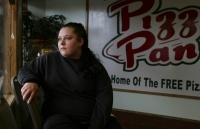c. 2008 Religion News Service
(UNDATED) Casey Hennacy went to the House of the Lord Church in Akron, Ohio, last year looking for repentance.
But the mercy she sought was from the law, not the Lord. The 20-year-old woman, wanted on three felony drug and theft warrants, was five months pregnant and didn’t want to give birth behind bars only to have the baby taken away.
She cried as she made her way into the church, which had been turned into a makeshift courthouse by the Fugitive Safe Surrender program. Safe Surrender, which was launched in Cleveland in 2005 before spreading to other cities, provided Hennacy with a safe setting to right her wrongs.
“I wouldn’t have turned myself in if it wasn’t at a church,” Hennacy, 21, said from her home in Akron, where she lives with her 6-month-old son, Skylor Mikal McLaughlin.
A new study by Kent State University researchers sheds light on what led Hennacy and other former fugitives to stop running.
Of the thousands of people who participated in the program in cities across the country, roughly 80 percent said having the site at a church played an important role in their decisions to give up hiding.
The study, based partly on exit surveys with the fugitives in seven cities, supports what community leaders already have said: Fugitive Safe Surrender works.
The findings, which will be presented and publicly released this week at a White House conference (June 26-27), also disclose the troubles fugitives faced while running from the law.
The fugitives had difficulties finding jobs and seeking college degrees. Fifty-one percent didn’t work at a job with a paycheck. Fifty-three percent graduated from high school, but only 16 percent had anything more than that.
Some surrendered because they wanted to start over or wanted to get a driver’s license. Others needed treatment for drug or alcohol abuse, wanted to get a job, feared getting arrested or felt pressure from family. Some did it for their children or for religious reasons.
Almost half the fugitives, including Hennacy, didn’t know what would happen to them at the church. Some thought the program was a trick and that they would be arrested without getting the help they sought.
“I turned around at the door quite a few times and cried a lot before I went in,” Hennacy said. “But once inside, I felt safe going through the process.”
Most of the fugitives were nonviolent offenders, but a few were wanted for murder, rape, robbery or attempted murder. They consulted with public defenders and had hearings before judges in the church.
At the sites, some were sent to jail, other had charges dropped, and some were given later court dates.
In court, a judge gave Hennacy a year of probation for her felony charges of aggravated possession of drugs, obstruction of official police business and theft of drugs. Her probation ends in August, and she attended six months of drug counseling.
Fugitive Safe Surrender was launched in August 2005 at Mount Sinai Baptist Church in Cleveland, where almost 850 fugitives participated, including 324 felony suspects. A $16 million federal grant helped spread the program to eight other cities.
This month in Detroit, a record 6,587 fugitives surrendered in the city’s four-day endeavor. Program directors had anticipated 1,500 people would attend.
In all, 16,000 cases have been resolved in nine cities.
Pete Elliott, a U.S. marshal based in Cleveland, helped conceive the program. He said that, aside from the statistics, the program’s success also should be evidenced by a concept impossible to quantify: the number of police officers’ lives saved.
“For every person who surrenders, that’s one less confrontation law enforcement has to have on the streets,” he said.
(BEGIN FIRST OPTIONAL TRIM)
In 2000, Cleveland police officer Wayne Leon was shot to death while trying to arrest a man wanted for a parole violation. The incident inspired Elliott, the Rev. C. Jay Matthews and former Assistant Cuyahoga County Prosecutor Douglas Weiner to create Fugitive Safe Surrender. They sought a way for people to turn themselves in without having a violent showdown with police.
“We’re taking the desperation out,” Elliott added, “and you can’t measure that.”
(END FIRST OPTIONAL TRIM)
One of the main barometers for gauging the program’s effectiveness is the number of people who “actually appear on their scheduled return to court dates,” wrote Kent State University professors Daniel Flannery and Eric Jefferis and projects director Jeffrey Kretschmar in the study.
Between 82 percent and 98 percent of the fugitives given follow-up court dates showed up, depending on the city.
Another important finding: 63 percent brought relatives.
“It’s not always a fugitive that makes the decision to surrender,” said Elliott, who has been to all of the sites in the nine cities. “It’s the family members’ influence. I’ve seen people who have been wanted for days and people who have been wanted for 15 years, and it affects everybody around them, not just themselves.”
(SECOND OPTIONAL TRIM FOLLOWS)
Hennacy brought her dad, Steven, with her. There was an arrest warrant out for him, too, for a contempt of court charge, and she says he was able to find a job and rebuild his life.
“I want everyone to know there’s another way,” said Hennacy. “They can start over and have their life back without having to worry about looking over their shoulder and getting caught.”
The program continues next month in Columbia, S.C.
(Brian Anthony Hernandez writes for The Plain Dealer in Cleveland.)
KRE DS END HERNANDEZ950 words, with optional trim to 850 or 775
A photo of Hennacy is available via https://religionnews.com.





